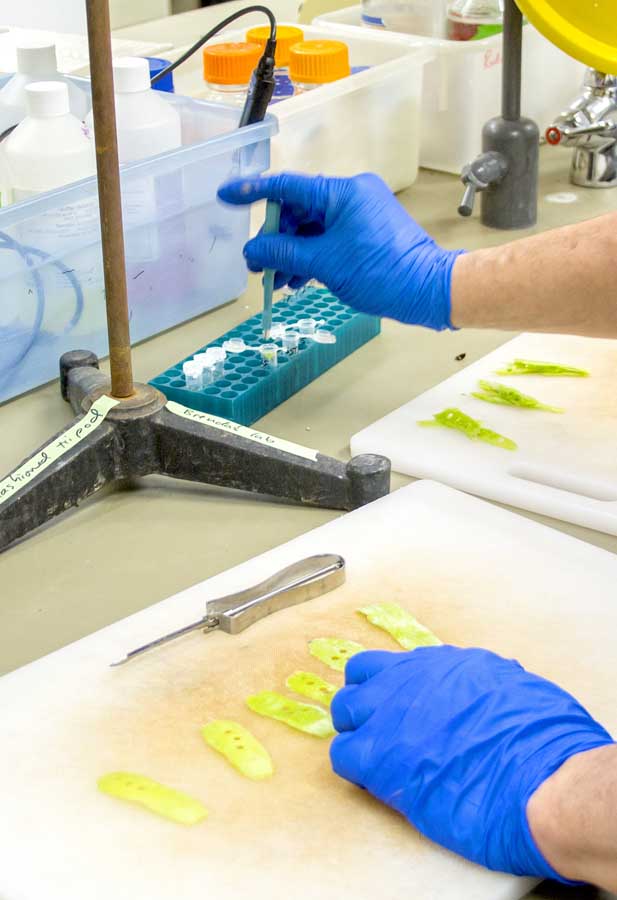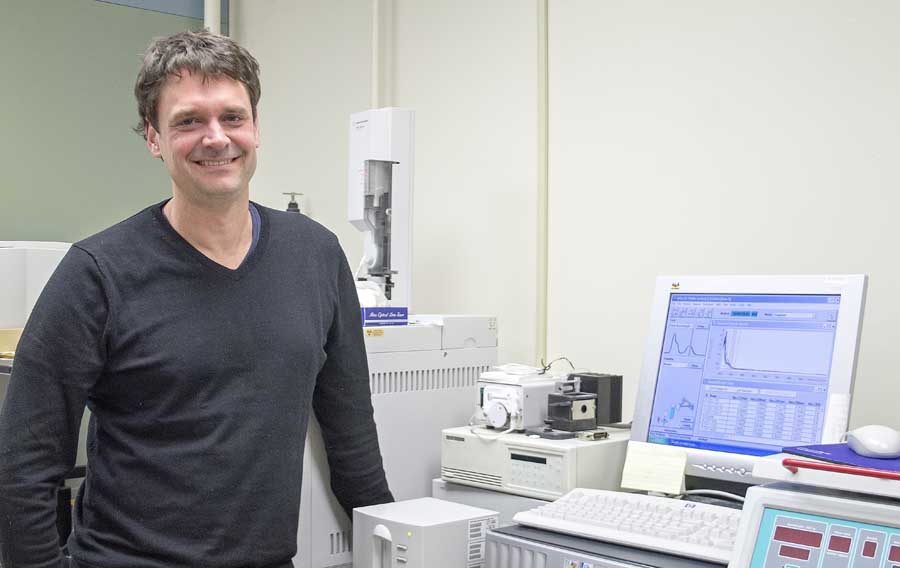Warehouses employ a variety of strategies to prevent superficial scald from spoiling apples during storage, but, in most cases, the only sign that those techniques aren’t working is the appearance of scald itself when fruit is removed from storage for distribution.
By then, it’s too late to save the fruit — often high-risk Granny Smith apples. But a new diagnostic tool that identifies scald signals months before the disorder becomes visible could help packers better manage their storage conditions to prevent it.
That’s the idea behind a tool being tested for industry use at the USDA Agricultural Research Service Tree Fruit Research Laboratory in Wenatchee, Washington.

Samples from a Granny Smith peel are placed in a vial for analysis by Ed Valdez, a lab technician at the U.S. Department of Agriculture’s Tree Fruit Research Laboratory in Wenatchee, Washington. (Kate Prengaman/Good Fruit Grower)
The test uses small samples from the peel of apples to see if compounds associated with the development of scald are increasing, said David Rudell, the project lead.
It’s a troubleshooting tool he hopes can be fine-tuned for commercial use, so this fall he partnered with Stemilt Growers to conduct pilot tests with apples from its warehouses.
“You can control for scald with proper storage, but the test indicates whether those storage conditions are working,” Rudell said.
This postharvest disorder detection should particularly benefit organic Granny Smith growers, since some of the existing options for preventing scald, such as diphenylamine (DPA) and 1-methylcyclopropene (MCP) can’t be used on organic fruit.
It’s the first of many tools Rudell envisions emerging from the work he and his colleagues are doing to identify chemicals that serve as biomarkers for a variety of fruit disorders triggered or exacerbated by storage conditions.
“Basically, we’re interrogating the fruit after some sort of stress,” Rudell said, comparing the test to a cholesterol test after a fast or a stress test to look at cardio-pulmonary function after exercise.

USDA Plant physiologist David Rudell stands in front of the spectrophotometer in his lab. He is using the equipment to develop a tool for warehouse managers to detect early warning signs of superficial scald before the disorder develops. (Kate Prengaman/Good Fruit Grower)
Since many postharvest disorders, such as browning, appear similar but are driven by different factors, the biomarker-based tests could also help packers identify the specific risks to better target storage strategies.
Looking for biomarkers to predict problems is a relatively new concept for the tree fruit industry but the potential of the emerging field is high, said Jim Mattheis, the lead scientist at the USDA Tree Fruit Laboratory.
“When you think about a warehouse manager, the more information they have about the fruit that sits in front of them, the more they like it because it helps them make decisions,” Mattheis said. “It will increase the chance of better outcomes for fruit quality and disorder management.”
Research is ongoing, but scientists believe storage scald results from injuries to the cells in the peel when they are first put into storage, but the damage accumulates, depending on conditions, and only appears as the distinctive surface peel blotching much later.
The scald test assesses levels of a group of compounds known collectively as conjugated trienols, which are found in pre-symptomatic fruit at much higher levels than in fruit that will not later develop the disorder, Rudell said.
To conduct the test, technicians put peel samples, treated with solvent, into an instrument called a spectrophotometer, which measures the concentration of specific chemicals based on how light moves through the solution.
If the levels of the biomarkers are rising, it’s a sign that the apples are at risk and that warehouse managers may need to adjust controlled atmosphere conditions. Rudell said he’s optimistic the tool could be employed by an agricultural service provider or done in-house at larger warehouses.
In addition to the tool, he’s excited about how the research looking for the biomarkers is increasing the understanding of what happens to fruit biochemically after harvest.
“Developing a tool is very exciting, don’t get me wrong, but for me, the most exciting part is that the scald is the result of an injury that occurs when we first put it in storage but we don’t see the damage for weeks. But with the test we can see the secondary metabolites that indicate that injury right away,” Rudell said. “From a scientific perspective, it is a fascinating subject.”
His lab is also working with biomarkers for soggy breakdown and soft scald.
“This is just one disorder, so there’s a lot of work still to be done,” Rudell said. “This is just one of these tools we hope to continue to introduce to the industry.”
Development of the tool itself is funded by $168,000 from the Washington Tree Fruit Research Commission.
But the research is just one piece of an ongoing five-year, $1.8 million project looking at genomic and metabolic factors that influence tree fruit quality, with the aim of developing more such tools for quality management, funded largely by the U.S. Department of Agriculture with additional support from AgroFresh and the Washington Tree Fruit Research Commission.
Rudell will present these findings at the Research Commission’s Apple Horticulture and Postharvest Research Review Jan. 25 in Yakima, Washington. •
– by Kate Prengaman






Leave A Comment